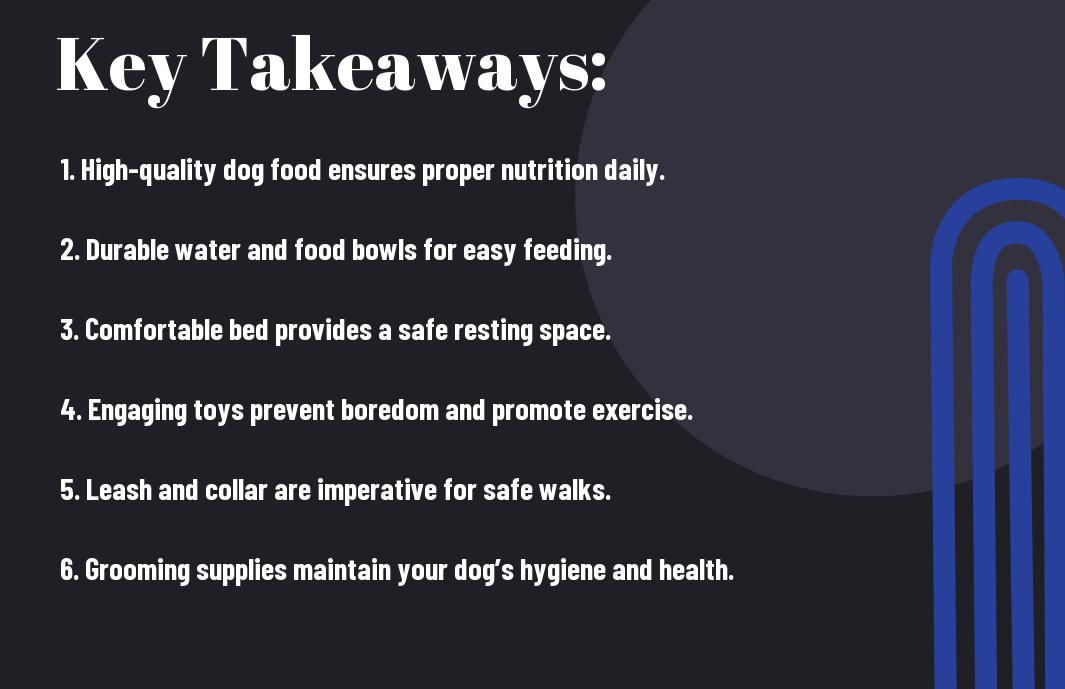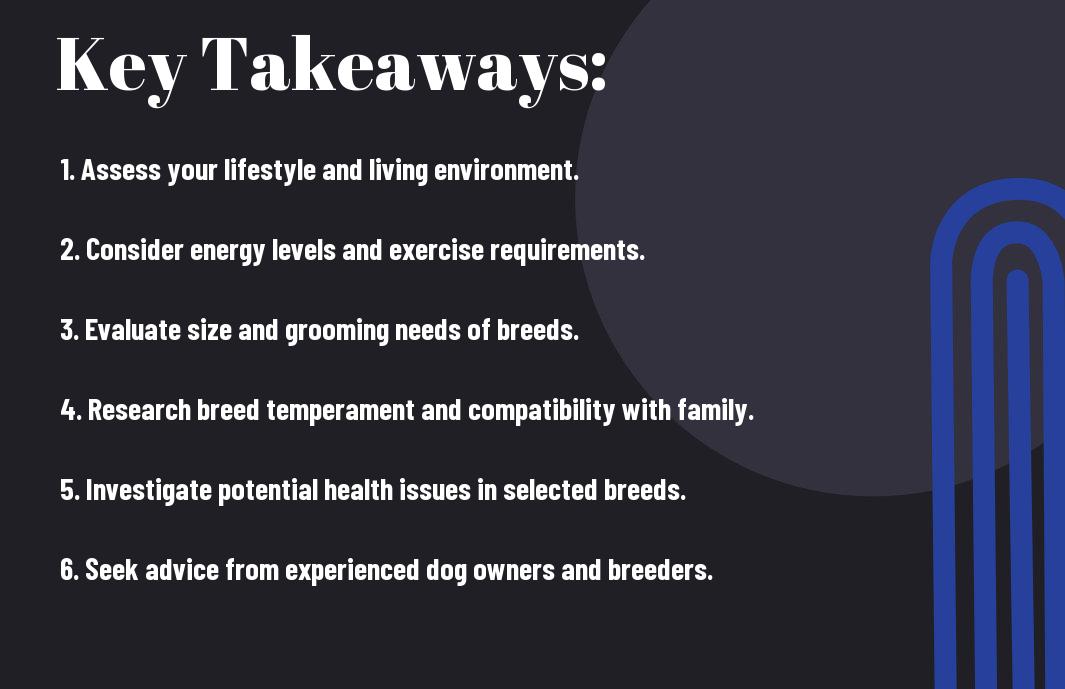There’s a perfect dog breed out there waiting for you, but finding it requires understanding your lifestyle, preferences, and living situation. Whether you’re an active outdoor enthusiast, a busy professional, or someone ready for companionship, the right breed can significantly enhance your day-to-day life. Different breeds come with distinct energy levels, grooming needs, and temperament, making it vital to choose one that aligns with your routine. This guide will help you navigate the options to ensure you find a furry friend that complements your life seamlessly.

Understanding Dog Breeds
For anyone considering bringing a dog into their life, understanding dog breeds is crucial to making a wise choice that aligns with your lifestyle. Different breeds come with their unique characteristics, energy levels, and needs, making breed selection a vital part of dog ownership. By selecting the right breed, you can ensure a harmonious and rewarding relationship, as you’ll be better equipped to meet the dog’s requirements and the dog’s temperament suits your personal or family dynamics.
The Importance of Breed Selection
Around the world, dogs are divided into various breeds, each designed with unique traits to fulfill specific roles, whether as companions, working dogs, or show dogs. Selecting the appropriate breed based on your living situation, daily schedule, and personal preferences is fundamental. Picking an unsuitable breed could lead to challenges later on, such as behavioral issues or health concerns, which could strain your relationship with your new furry companion.
| Consideration | Consequence |
| Active lifestyle | High-energy breeds might suit you best. |
| Living space | Small breeds may adapt better to apartments. |
| Allergies | Hypoallergenic breeds could be a solution. |
| Work schedule | Some dogs require more time and attention. |
Additionally, the breed’s typical health issues can influence your long-term commitment. Each breed has its own potential for genetic disorders, which you may need to consider in terms of both financial and emotional investments. Thus, educating yourself about breed characteristics helps you avoid unnecessary hardships.
- Understanding breed characteristics is crucial.
- Consider health issues when choosing.
- Factors such as energy level matter significantly.
- Selecting the wrong breed can lead to behavioral challenges.
Thou must take your time when considering which breed aligns with your lifestyle and needs.
Common Types of Dog Breeds
Indeed, dog breeds are often categorized into groups based on their traits and historical functions. Recognizing these groups will help you narrow down your options. Some of the most common types include working breeds, toy breeds, sporting breeds, hound breeds, and herding breeds. By understanding the purposes these breeds serve, you can make a more informed decision about which type might be best suited for your home.
| Type of Breed | Examples |
| Working | Siberian Husky, Boxer |
| Toy | Chihuahua, Pomeranian |
| Sporting | Labrador Retriever, Golden Retriever |
| Hound | Beagle, Dachshund |
| Herding | Australian Shepherd, Border Collie |
Understanding these common types can significantly impact your decision-making process. Different breeds have distinctive needs regarding exercise, grooming, and socialization. This information is particularly helpful when matching a dog’s characteristics to your lifestyle and readiness for pet ownership.
- Identify type of breed for better alignment.
- Consider exercise needs of the breed.
- Understand social behaviors required.
- Grooming demands vary among different breeds.
Thou should keep in mind the breed’s adaptability to your daily life.
Temperament and Behavior Traits
Behavior plays a significant role in how well a dog integrates into your home. Each breed has inherent temperament traits that often manifest in their behavior patterns. Understanding these traits will assist you in selecting a dog that complements your family dynamics. Dogs such as Golden Retrievers are known for their friendly and gentle nature, while others may be more protective and reserved, like the Rottweiler.
Moreover, some breeds require more socialization and training than others. Understanding whether a breed is prone to being independent, stubborn, or desires continuous interaction can guide your expectations and help you allocate the appropriate resources for training and social activities.
This insight into temperament and behavior traits is crucial for ensuring lasting happiness and companionship between you and your dog. By considering exercise requirements, social needs, and anxiety levels, you can foster a nurturing environment where your dog thrives.
Assessing Your Lifestyle
It’s necessary to evaluate your lifestyle closely when selecting the right dog breed for you. Different breeds have unique needs, and understanding how they align with your daily routine will help ensure a harmonious life with your new pet. Various factors, such as your activity level, living space, family dynamics, and work commitments, play significant roles in determining which dog breed may be the best fit for your situation.
Activity Level and Exercise Needs
Along with assessing your lifestyle, consider your activity level and exercise needs. Some breeds require more physical activity to maintain their health and happiness while others are more suited for a more laid-back lifestyle. If you enjoy outdoor activities like hiking, running, or long walks, a breed that thrives on exercise, such as a Labrador Retriever or a Border Collie, may align well with your active lifestyle. Conversely, if you prefer a more sedentary life or have physical limitations, a smaller breed like a Bulldog or Shih Tzu might be more appropriate.
It’s also necessary to factor in your daily schedule and energy levels. If you find yourself busy with work or other commitments, a lower-energy breed that requires less exercise could be the perfect match. Always consider the exercise needs of different breeds and honestly assess the amount of time and energy you can dedicate to your dog’s physical activity.
Space Considerations: Apartment vs. House
One important aspect to consider is your living situation: apartment versus house. If you reside in a smaller apartment, including breeds that adapt well to limited spaces is vital. Smaller dog breeds like French Bulldogs or Chihuahuas may thrive in apartments, while larger breeds may require more space to move around comfortably. Even if you’re in a spacious house, make sure you can provide the necessary environment for your dog to thrive, such as a yard for play and exercise.
In fact, regardless of whether you live in an apartment or a house, you can also consider factors like proximity to parks where your dog can play. If you opt for a dog breed that needs more space but live in an apartment, ensure you are committed to providing ample walks and outings.
Family Dynamics: Children and Other Pets
Above all, you must assess your family dynamics when choosing a dog breed. If you have young children or other pets, select a breed that is known to be gentle and friendly. Some dogs are more tolerant of children and other animals, making them a better fit for a family environment. Breeds like Golden Retrievers or Beagles are known for their friendly demeanor, while some breeds may not adapt as well in a bustling family setting.
With various breeds available, assess the temperament of each breed against your family’s unique dynamic. It’s important to ensure that your new dog can coexist harmoniously within your household, particularly when children or other pets are involved.
Work Schedule and Time Commitment
Dynamics in your work schedule and time commitment are necessary factors that can influence your choice of dog breed. If you work long hours or have an unpredictable schedule, consider breeds that are more independent and can handle being alone for extended periods. Breeds like Basset Hounds or Greyhounds tend to adapt well to less active lifestyles and can manage some alone time without suffering from separation anxiety.
The level of time commitment you can allocate for training, socialization, and daily care also affects the breed’s suitability for your life. Some breeds require more grooming, training, and attention than others, so it’s necessary to align these requirements with your available time and resources.
Health and Care Requirements
Once again, understanding the health and care requirements of a dog breed is pivotal to ensuring a harmonious relationship between you and your furry companion. Each breed comes with its own set of needs, and knowing these can help you provide the best environment for your pet. Whether you are drawn to a high-energy breed or a low-maintenance lap dog, equipping yourself with this knowledge will make a significant difference in your dog’s quality of life and longevity.
Grooming Needs for Different Breeds
Grooming is an crucial aspect of your dog’s health and wellbeing, influencing not just their appearance but also their comfort. Some breeds, like Poodles and Shih Tzus, require regular grooming sessions due to their long, curly coats, which can mat and tangle without proper maintenance. On the other hand, short-haired breeds such as Beagles and Boxers may only need occasional brushing to keep their coats healthy. Assessing your grooming timeline can help you gauge how much time and effort you’ll have to invest.
Additionally, regular grooming can also play a role in spotting underlying health issues, such as skin problems or parasites. By grooming your dog consistently, you are not only keeping them clean but also fostering a closer bond and improving their overall health. Be mindful that some breeds have unique grooming requirements, including specific nail trimming needs or ear care, which are crucial for prevention against infections and other health concerns.
Common Health Issues by Breed
Across different breeds, there are certain health issues that are more prevalent due to genetic factors. For example, larger breeds such as Great Danes often experience issues related to joint health, including hip dysplasia, while smaller breeds like Chihuahuas may be more susceptible to dental problems. Understanding these common health concerns can guide you in making better choices about potential veterinary care and preventive measures, ultimately reducing the likelihood of expensive medical bills.
Hence, being aware of the specific conditions associated with your dog’s breed is vital for early detection and prompt treatment. Regular veterinary check-ups can assist in monitoring and mitigating these issues, ensuring your beloved pet remains as healthy as possible. Additionally, you should consider health insurance options that cover breed-specific issues, providing you with peace of mind and financial protection against unforeseen medical expenses.
Lifespan and Aging Considerations
Against the backdrop of breed selection, lifespan and aging factors are crucial to consider. Different breeds have varying average lifespans, with smaller breeds typically living longer than their larger counterparts. For instance, Dachshunds may live up to 15 years, while Great Danes often have shorter lifespans averaging around 7 to 10 years. Understanding these differences will help you prepare for the long-term commitment that a pet entails.
It is also important to consider how your dog’s aging might affect their daily needs. As dogs age, their energy levels may decrease, and they may require adjustments in their diet and exercise routine. Regular veterinary check-ups will assist in monitoring their health and adaptability, ensuring that you meet their changing needs as they transition into their golden years. Providing a comfortable environment and appropriate care during this stage of life can greatly enhance their quality of life.

Dog Breed Categories
Unlike many other pets, dogs come in various breeds that are tailored to perform specific functions, each with unique traits and characteristics. Understanding dog breed categories can help you identify which type of canine best aligns with your lifestyle, needs, and preferences. The categories include Working Dogs, Sporting Dogs, Hound Breeds, Toy Breeds, and Herding Breeds, each offering distinct attributes and energy levels that cater to diverse owners across the globe.
Working Dogs: Role and Responsibilities
An imperative part of many communities, Working Dogs are bred for their strength, intelligence, and specific skills. These dogs typically assist humans in various roles such as police work, search and rescue, and service for individuals with disabilities. They are known for their ability to learn quickly and perform tasks with precision, making them ideal partners for challenging assignments.
Responsibilities associated with these breeds often demand a high level of training and engagement. Whether it’s pulling sleds in harsh conditions or guarding property, Working Dogs require dedicated time and discipline from their owners. Therefore, if you opt for a working breed, it’s imperative that you are prepared to invest in consistent training and ample physical activity.
Sporting Dogs: Energy and Enthusiasm
Categories of Sporting Dogs encompass breeds that are energetic, enthusiastic, and always ready for action. These dogs are known for being exceptional athletes, often used in activities like hunting, field trials, and agility competitions. Breeds in this category generally come with a friendly disposition, making them excellent companions for active families and individuals.
Further to their athleticism, Sporting Dogs require a substantial amount of exercise to channel their abundant energy effectively. Regular activities and mental stimulation are imperative for preventing behavioral issues, particularly in high-energy breeds. Whether it’s swimming, running, or participating in dog sports, your commitment to keeping them active is vital for their happiness.
Hound Breeds: Scent and Tracking Abilities
Enthusiasm for adventure is a hallmark of Hound Breeds, known for their exceptional scenting and tracking abilities. These breeds have a rich history in hunting, given their instinctual talents to follow scents or trails for long distances. Their inherent drive makes them both captivating companions and useful working dogs for tracking or search and rescue missions.
And while their talents are indeed impressive, owning a Hound Breed also requires you to accommodate their exercise needs. These dogs thrive with regular long walks or opportunities to roam freely. Ensuring they channel their instincts and energy appropriately is critical to fostering a responsive and content companion.
Toy Breeds: Companionship and Small Space Living
Beside the larger breeds, Toy Breeds are often perfect for those with limited space or who desire a smaller companion. These dogs are typically characterized by their affectionate nature and strong bond with their owners. Their diminutive size allows them to fit into small living quarters, making them ideal for apartment dwellers or individuals with mobility constraints.
Dogs of this category can bring immense joy and companionship to your life, although they still require socialization and regular playtime. Their small size doesn’t equate to low maintenance; their needs and personalities can be just as vibrant and demanding as their larger counterparts. Therefore, engaging with them through interactive play can enhance your bond.
Herding Breeds: Intelligence and Activity
Activity levels in Herding Breeds are among the highest, thanks to their intelligence and storied purpose of managing livestock. These dogs are known for their problem-solving abilities, which require appropriate mental stimulation. As a result, they excel in obedience training, agility tasks, and other interactive games, making them a joy for active owners.
Sporting breeds can often retreat if their energy isn’t adequately utilized; hence, structured activities like training or agility courses become key elements in keeping them satisfied and well-behaved. With your involvement in their training and development, these dogs can flourish, showcasing their remarkable capabilities.
Financial Responsibilities
Keep in mind that bringing a dog into your life requires more than just love and companionship; it also demands a thorough understanding of your financial responsibilities. Owning a dog can significantly impact your budget, and it’s crucial to weigh these costs against your financial capabilities before making a decision. From initial purchase or adoption fees to ongoing care expenses, understanding the financial aspect of dog ownership is key to a successful and fulfilling relationship with your furry friend.
Initial Costs: Adoption and Purchase
After deciding to welcome a dog into your life, you will face initial costs associated with either purchasing a dog from a breeder or adopting from a shelter. Purchasing a purebred dog can range from hundreds to thousands of dollars, especially for popular breeds. On the other hand, adopting a dog from a shelter usually comes with a significantly lower cost, which often includes initial health check-ups and vaccinations. However, keep in mind that even when adopting, there may be fees associated with the application process or other services the shelter offers.
Additionally, you should consider other immediate expenses, such as grooming, puppy training classes, and the purchase of necessary supplies, such as food bowls, bedding, and leashes. These initial costs can add up quickly, so it’s important to assess your budget accordingly before making a commitment.
Long-term Care Expenses: Food, Vet, and Supplies
About the long-term financial responsibilities, you should prepare for ongoing expenses related to your dog’s care. These long-term care expenses typically include food, regular veterinary visits, vaccines, and routine check-ups. Depending on the size and breed of your dog, the cost of food can vary significantly. Larger dogs often consume more food, which can escalate your monthly budget considerably. Moreover, having a regular vet is crucial, and their services include not just routine check-ups but also unexpected health issues that may arise.
For instance, you might consider budgeting for crucial supplies like grooming tools, toys, and training equipment. Factor in unexpected costs like emergency medical situations which can be financially burdensome, especially if they require specialized care or extensive treatment. By keeping a close eye on these ongoing expenses, you will be better prepared for the demands of dog ownership.
Insurance Considerations
Across dog ownership, it’s wise to consider pet insurance as part of your financial planning. Pet insurance can help alleviate the financial burden of unexpected veterinary expenses. Various plans offer coverage options that range from basic accident-only policies to comprehensive packages that include preventive care, so it’s important to evaluate which type best suits your needs. Remember that the younger and healthier your dog is when you enroll them in insurance, the more affordable the premiums typically are.
Food for thought: having insurance might not eliminate all veterinary costs, but it can protect you from substantial out-of-pocket expenses, providing peace of mind as you care for your pet. Just as you would with your health insurance, take time to read the fine print and understand what conditions are excluded or what limits may apply to your policy to make informed decisions about this important aspect of dog ownership.

Finding the Right Breed
Not every dog is suited for every lifestyle. Understanding which breed aligns with your daily routine, activity level, and living situation is necessary for ensuring a harmonious relationship with your new pet. By taking the time to consider your circumstances, you can make an informed choice that benefits both you and your future canine companion.
Researching Different Breeds
Across various websites and resources, you’ll discover extensive information on different dog breeds, from their average size and temperament to specific health issues. Start by checking out reputable breed catalogs, websites, and forums where dog enthusiasts share their experiences and insights. This research will give you a foundational understanding of the breeds that pique your interest, allowing you to assess how each fits into your unique lifestyle.
Additionally, pay attention to breed traits such as energy levels, trainability, and grooming needs. For instance, while some breeds may require frequent exercise or have high grooming demands, others might be more suitable for a sedentary lifestyle. By closely evaluating these characteristics, you will be better prepared to make a choice that suits your day-to-day life.
Consulting Professionals: Breeders vs. Shelters
For those looking to bring a dog into their home, it’s important to consider whether to adopt from a shelter or purchase from a breeder. Each option has its advantages, and understanding these can help you make an informed decision. Reputable breeders often provide information about the health history and temperament of the breed, giving you insight into factors that affect the dog’s long-term well-being. Conversely, shelters typically have a myriad of breeds and mixes available, often at lower costs, and can provide the benefit of giving a dog in need a second chance.
A visit to both breeders and shelters can offer you valuable perspectives. When meeting with breeders, ask about health screenings, socialization practices, and the environment in which the puppies are raised. On the other hand, talking to shelter staff can provide you with information on a dog’s behavior, past experiences, and overall suitability for your lifestyle. Engaging with both sources helps to ensure you are making a well-rounded decision.
Breed Compatibility: Matching Traits to Lifestyle
Before making a final decision, assess how well a dog’s traits align with your lifestyle. For example, if you lead an active life, breeds like Border Collies or Labrador Retrievers may be a great fit due to their high energy levels and love for exercise. Conversely, if you prefer a more relaxed atmosphere, consider breeds that are known for being calm, such as the Bulldog or Basset Hound. Taking the time to match breed characteristics with your daily routine can lead to a happier, more fulfilling companionship.
Shelters and rescue organizations often provide resources on each dog’s temperament and needs, which can be incredibly helpful in this evaluation process. Understanding your own lifestyle as well as the specific traits of a breed can significantly enhance the likelihood of a successful match.
Conclusion
Considering all points discussed, choosing the right dog breed for your lifestyle requires careful thought and assessment of your unique circumstances. It is crucial to reflect on the time you can dedicate to training, exercise, and companionship. Your living situation, work commitments, and family dynamics all play significant roles in determining which breed will harmonize with your daily routine and environment. By understanding your preferences and the characteristics of different breeds, you can make an informed decision that will lead to a fulfilling relationship with your new canine companion.
Ultimately, the goal is to find a breed that not only matches your lifestyle but also enriches it. The right dog can bring joy, companionship, and a sense of responsibility into your life. It’s important to ensure that you’re prepared for the commitment that comes with pet ownership, and by taking the time to evaluate your needs against the traits of various breeds, you will set the foundation for a happy and healthy bond with your dog.
Q: How do I determine which dog breed is best suited for my activity level?
A: Assessing your activity level is key when choosing a dog breed. Consider how much time you can dedicate to daily exercise and playtime. Active breeds, such as Border Collies or Labrador Retrievers, require plenty of physical activity and mental stimulation. In contrast, more laid-back breeds, like Bulldogs or Basset Hounds, may be more suitable for individuals with a less active lifestyle. Evaluate your daily routine, including walks, runs, or play sessions, to find a breed that matches your lifestyle.
Q: What factors should I consider regarding my living situation when selecting a dog breed?
A: Your living situation greatly influences the type of dog breed that will thrive in your home. If you live in a small apartment, consider breeds that are known for being more adaptable to smaller spaces, such as French Bulldogs or Cavalier King Charles Spaniels. Alternatively, if you have a large house with a yard, you might opt for larger, more energetic breeds like Golden Retrievers or German Shepherds. Additionally, think about any breed restrictions your housing may have and whether you have access to nearby parks for walks and socialization.
Q: How does my family situation impact the choice of dog breed?
A: Your family situation plays a significant role in selecting the right dog breed. If you have young children, you may want to prioritize breeds known for their gentleness and patience, such as Beagles or Boxers. On the other hand, if you live alone or have older children, you may prefer breeds that are more independent, like Shiba Inus or Whippets. Additionally, consider any allergies family members may have, leading you to hypoallergenic breeds such as Poodles or Schnauzers. It’s important to find a breed that complements your family’s unique dynamics and lifestyle.










